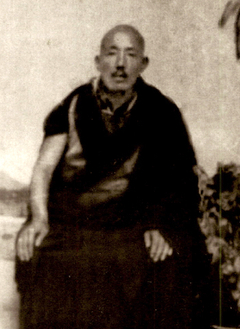Biography of Pema Kunzang Rangdrol
Brief Biography of Pema Kunzang Rangdrol (1916–1984)
by Alak Zenkar Rinpoche
The sublime Kharlek Tulku Pema Kunzang Rangdrol was born in the Fire Dragon year of the fifteenth calendrical cycle to the Gartsang family in a place called Kamtok Geda in Jomda County in the golden Drichu valley on the banks of the gently flowing river. At the age of about four or five he was recognized as the tulku of Kharlek Khenpo Pema and invited to the hermitage at Kharlek. With Langshing Lama Pema as his tutor he learned to read and write and studied medicine and astrology. He then continued his studies for the following eleven years or so, travelling to Dzogchen Śrī Siṃha, Tsering Jong, the Yamāntaka practice cave and elsewhere. He also visited the three centres of Dorje Drak, Mindrolling and Palri, as well as Katok, Palyul, Shechen, Palpung, Dzongsar, Muksang and other places. He sat at the feet of numerous learned and accomplished masters, including Minling Chung Rinpoche Ngawang Chödrak, Dzongsar Khyentse Rinpoche Jamyang Chökyi Lodrö, Dzogchen Khenpo Abu Lhagang, Shechen Kongtrul Pema Drimé Lekpé Lodrö, Katok Khenpo Lekshé Jorden, Khenpo Nüden, Dzogchen Khenpo Yönten Gönpo and Pema Tsewang. He thus studied all the major texts of sūtra and mantra and the sciences, and became a highly learned scholar.
In addition, he actively sought empowerments, teachings and reading transmissions and thus received the surviving transmissions for the precious Word of the Buddha (Kangyur) and Translated Treatises (Tengyur), as well as the Nyingma Kama, the Precious Treasury of Revelations (Rinchen Terdzö), Treasury of Instructions from the Eight Chariots of the Practice Lineage (Damngak Dzö), and the collected writings of learned and accomplished masters, such as most importantly the omniscient father and son,[1] Rongzom, Minling father and son, the Fifth Dalai Lama, Jonang Tāranātha, Khyentse and Kongtrul, Ju Mipham and Patrul Rinpoche. Indeed, there may not have been a surviving transmission that he did not receive. Since his record of received teachings (gsan yig) was a large volume of around four hundred pages, he later became renowned for possessing an unrivalled wealth of teachings, empowerments and transmissions.
Above all, he followed Adzom Gyalse Gyurme Dorje as his uncommon guru and received numerous ripening and liberating instructions from him, including the Seventeen Dzogchen Tantras and the Four Sections of the Heart-Essence (Nyingtik Yabshi), which he then applied in practice. He recognized pure awareness (rigpa), reached the culmination of experience and realization, and extended his activity without partiality. He granted empowerments, reading transmissions and instructions for collections such as the Treasury of Instructions (Damngak Dzö) to such great masters as Minling Khenchen, Chung Rinpoche, and Dordrak Rigdzin Chenmo.
He also helped to sponsor the golden roof on the main temple at Mindrolling and the printing of such texts as the Guru’s great secret commentary on Yangdak, the collection of subtle illusion (sgyu ‘phrul phra mo), Nub’s commentary on the Gathering of Intentions Sūtra (Düpa Do)[2] and the further commentary known as The Brilliant Light of Dawn (gzi ldan ‘char kha’i ‘od snang),[3] as well as the collected writings of the Mindrolling brothers and Rongzom.
He was eventually invited by the Tibetan language students of Derge, Szechuan Province, to Dzogchen Śrī Siṃha, where he was appointed as a teacher to all students. He bestowed the unending nectar of the profound and vast, as he taught history and so on in a way that matched the needs of those he guided.
Finally, at the age of sixty-nine,[4] in the Wood Mouse year of the sixteenth calendrical cycle, he passed away in Karma Lhateng.
The master’s collected compositions include a commentary on the Aspiration of Samantabhadra, a commentary on The Spontaneous Vajra Song of Fulfilment and Confession, a non-sectarian history of the Dharma, and a biography of Gyalse Gyurme Dorje.
Tupten Nyima composed this out of devotion.
| Translated by Adam Pearcey, 2021.
Bibliography
Tibetan Edition
thub bstan nyi ma. “rtsom pa po’i lo rgyus mdor bsdus” in ris med chos 'byung. Chengdu: si khron mi rigs dpe skrun khang, 1986, 1987 (BDRC W10130) pp. 1–4
Secondary Sources
Dalton, Jacob P. The Gathering of Intentions: A History of a Tibetan Tantra. New York: Columbia University Press, 2016
Version 1.2-20220504
